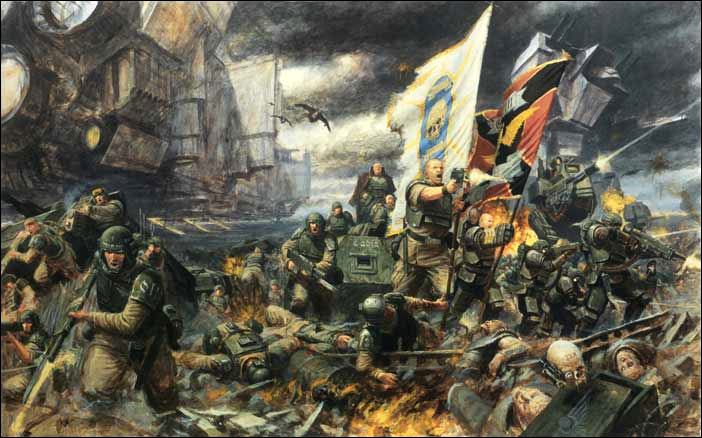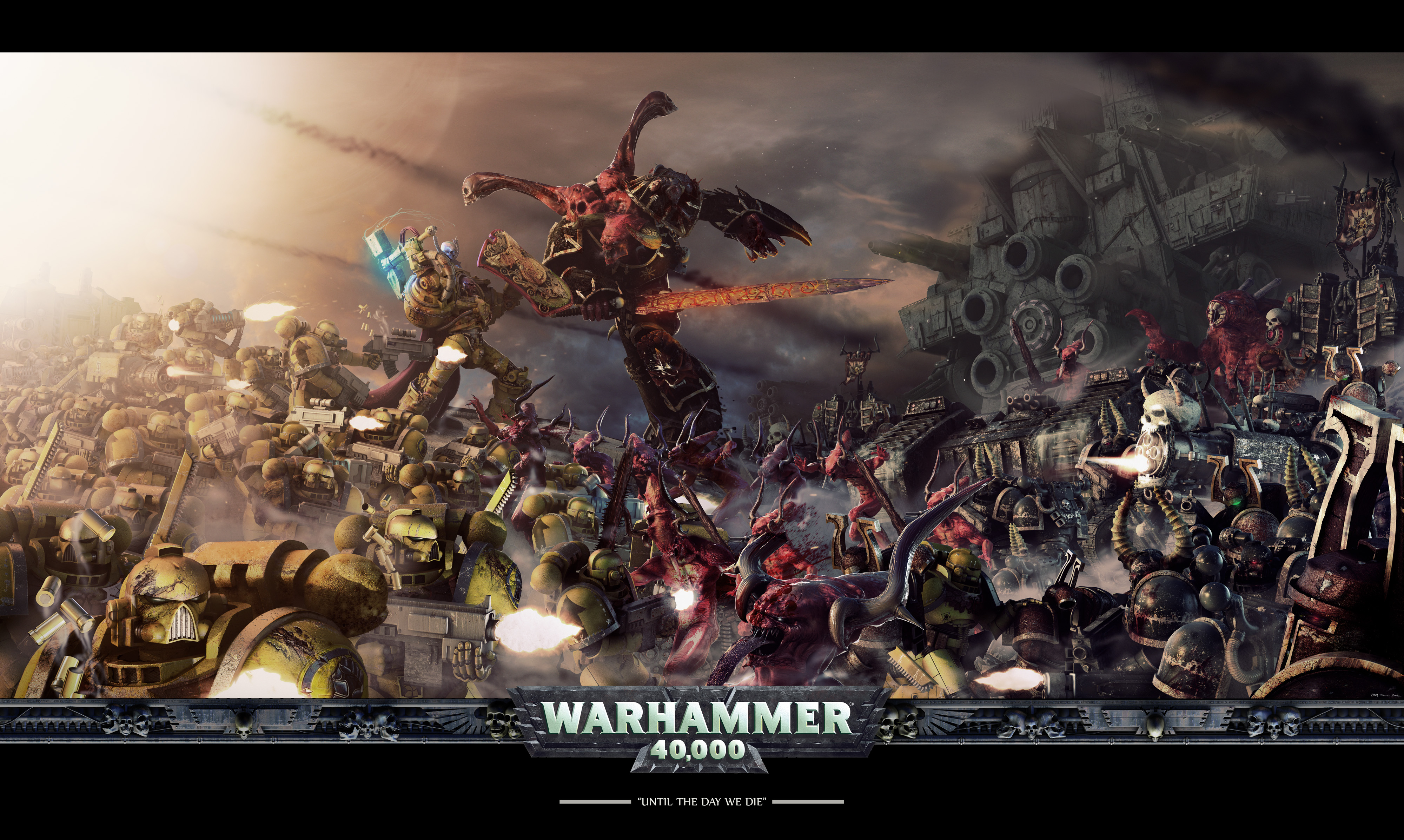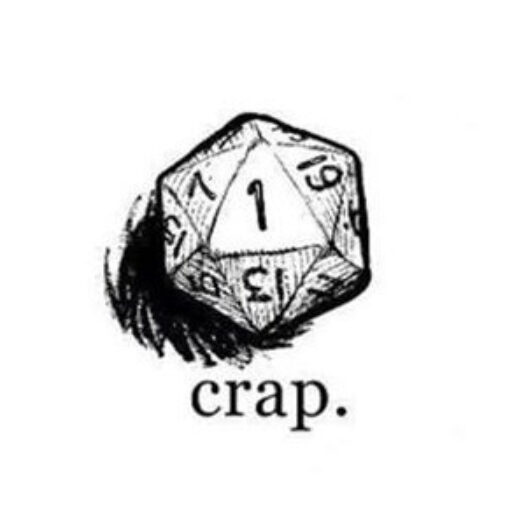 This otherwise great idea was crushed beneath the wheels of the GW juggernaut that was just starting to get rolling at the time. I don’t think I have to tell anyone how 40k turned out, but “permissive” and “marvellously camp” aren’t words I’d use to describe it. That core idea of customizable squad level stuff lived on though, in the form of Necromunda, then later as the ill-fated Inquisitor game. After they had abandoned Warhammer Fantasy Roleplay, GW wasn’t going to come up with a 40k Roleplaying, but fortunately they spun off the rights to their Black Library Publishing subsidiary, then it eventually made its way to Fantasy Flight. Because as far as I can tell, everything does, and bless them for it.
It did so as the rest of the Black Library has been pretty successful. People who like 40k tend to like reading about 40k too and they’ve harnessed some fairly good writers; all dependable Sci-Fi writers although Abnett really is a standout. In doing so, the background of the 40k universe has been fleshed out quite a bit beyond the table-top wargame and its sourcebooks. In creating a richer background, they haven’t contradicted the penultimate sentence of the pre-amble, there IS only war…
This otherwise great idea was crushed beneath the wheels of the GW juggernaut that was just starting to get rolling at the time. I don’t think I have to tell anyone how 40k turned out, but “permissive” and “marvellously camp” aren’t words I’d use to describe it. That core idea of customizable squad level stuff lived on though, in the form of Necromunda, then later as the ill-fated Inquisitor game. After they had abandoned Warhammer Fantasy Roleplay, GW wasn’t going to come up with a 40k Roleplaying, but fortunately they spun off the rights to their Black Library Publishing subsidiary, then it eventually made its way to Fantasy Flight. Because as far as I can tell, everything does, and bless them for it.
It did so as the rest of the Black Library has been pretty successful. People who like 40k tend to like reading about 40k too and they’ve harnessed some fairly good writers; all dependable Sci-Fi writers although Abnett really is a standout. In doing so, the background of the 40k universe has been fleshed out quite a bit beyond the table-top wargame and its sourcebooks. In creating a richer background, they haven’t contradicted the penultimate sentence of the pre-amble, there IS only war…
 …it’s just a different type of war.
The themes set out by the Warhammer Fantasy Roleplay setting – paranoia, corruption and imminent apocalypse – were cold war themes, with the dreaded commie amongst us and the horrors of radioactive annhilation, both fast and slow, translated to middle ages fantasy setting. The same themes translate well to the grimdark future too – perhaps in a more understandable way. It is a cold war RPG as much as Paranoia or Twilight 2000. Plenty of other places have written up great summaries of the 40k universe, not least of which tvtropes.com. But the particular part of the universe that Dark Heresy occupies is far from the grimdark warsplosion front lines that are represented by the tabletop game. The tabletop game is full of enemies that are the best of the best of the 40k universe. Dark Heresy is populated by enemies that are the worst of the rest. Space Marines, the iconic standard of the tabletop game, don’t feature in Dark Heresy much. If they do, they feature as god-like supermen or, more likely, a TPK-ing villain. Imperial guardsmen, the shittiest of all humans in 40k are Schwarzneggerian badasses in DH.
…it’s just a different type of war.
The themes set out by the Warhammer Fantasy Roleplay setting – paranoia, corruption and imminent apocalypse – were cold war themes, with the dreaded commie amongst us and the horrors of radioactive annhilation, both fast and slow, translated to middle ages fantasy setting. The same themes translate well to the grimdark future too – perhaps in a more understandable way. It is a cold war RPG as much as Paranoia or Twilight 2000. Plenty of other places have written up great summaries of the 40k universe, not least of which tvtropes.com. But the particular part of the universe that Dark Heresy occupies is far from the grimdark warsplosion front lines that are represented by the tabletop game. The tabletop game is full of enemies that are the best of the best of the 40k universe. Dark Heresy is populated by enemies that are the worst of the rest. Space Marines, the iconic standard of the tabletop game, don’t feature in Dark Heresy much. If they do, they feature as god-like supermen or, more likely, a TPK-ing villain. Imperial guardsmen, the shittiest of all humans in 40k are Schwarzneggerian badasses in DH.

- A single round from the Space Marine’s iconic weapon, the Bolter, costs as much as 320 bullets for the guns the plebs of Dark Heresy are going to use.
- The Lasgun – known to 40k players as the Flashlight due to its ineffective nature – is a vicious instrument of death. Two successful body shots with a Lasgun can cause the victim to fly back up to 10 feet, spewing blood from their mouth, knocking down anyone in its path and then crumpling dead on the ground. Yes, this game has critical tables. If you hit only once, it would take the victim weeks to recover without medical attention and rest.
- The humble Flak jacket, given to Guardsmen to make their corpses easier to pick up and form sandbag walls with their corpses, is actually pretty great in DH, having a 1 in 5 chance of completely negating shots from regular pistols. Not just stop-you-from-being-killed, but stop-you-from-being-bothered.
- Those 40k Grey Knights armies that feature Inquisitors and their retinues? If you max out your character’s career, your character would translate to 40k as one of those retinue members. I.e. the ablative wounds the Inquisitor surrounds himself with. That’s the pinnacle of a DH PC’s career trajectory, before being shot by a space-commie with a silent gun that shoots so fast it sets fire to the air as it passes.
 Whatever you choose, you start off as Acolytes; the lowest level of Inquisitorial servant. Above you are the Interrogators, agents on their way to being Inquisitors themselves and then above them, the Inquisitors. The Inquisitor is a for-all-intents-and-purposes powerful boss man who send his massive coterie of agents off on missions as they unravel heresies and plots, often over the course of centuries. Interrogators will end up dealing with the super important stuff and the acolytes (the players) will get to start unravelling the plots from the ground up. That might sound unfulfilling, but the work the Acolytes do still has a broad scope to it – the bosses don’t swoop in to finish off the tough stuff for you, you still get to do that. So an Acolyte group might discover, infiltrate and destroy a coven of heretics who had a big smuggling ring, while the Interrogators are tracking down what is being smuggled, while the Inquisitors might be uncovering whoit was who needed a smuggling ring set up and what its true purpose it is. Having this split is handy for gamesmasters because the missions given don’t have to run together – the Inquisitor may be working on dozens of leads and the Acolytes may get switched from one to the next. This helps underline two central themes of Dark Heresy and 40k in general: It Never Ends and You Are A Cog In A Machine.
Whatever you choose, you start off as Acolytes; the lowest level of Inquisitorial servant. Above you are the Interrogators, agents on their way to being Inquisitors themselves and then above them, the Inquisitors. The Inquisitor is a for-all-intents-and-purposes powerful boss man who send his massive coterie of agents off on missions as they unravel heresies and plots, often over the course of centuries. Interrogators will end up dealing with the super important stuff and the acolytes (the players) will get to start unravelling the plots from the ground up. That might sound unfulfilling, but the work the Acolytes do still has a broad scope to it – the bosses don’t swoop in to finish off the tough stuff for you, you still get to do that. So an Acolyte group might discover, infiltrate and destroy a coven of heretics who had a big smuggling ring, while the Interrogators are tracking down what is being smuggled, while the Inquisitors might be uncovering whoit was who needed a smuggling ring set up and what its true purpose it is. Having this split is handy for gamesmasters because the missions given don’t have to run together – the Inquisitor may be working on dozens of leads and the Acolytes may get switched from one to the next. This helps underline two central themes of Dark Heresy and 40k in general: It Never Ends and You Are A Cog In A Machine.
 Play is conducted with a d10. That’s all you need. Stats are the usual Warhammer statline, with scores from 1 – 100 in each stat, but most mortals will never see the high side of 50. To make a test (whether it is shooting a cultist, reprogramming a servitor made out of a skull or trying to remember a litany) you try to roll under the relevant stat. Modifiers are applied to that stat (not the roll) if the test is easy or difficult. So shooting that cultist in the head would shrink your range by 20, whereas you would expand your range by 10 if you had worked on this type of floating skull servitor for a few years. Mechanically, the game owes a lot to the 2nd Edition of Warhammer Fantasy Roleplay. Anyone passingly familiar with that game will recognise most of everything. Actually, it owes a bunch of things to a bunch of other games, not always directly, but they should be recognisable.
Play is conducted with a d10. That’s all you need. Stats are the usual Warhammer statline, with scores from 1 – 100 in each stat, but most mortals will never see the high side of 50. To make a test (whether it is shooting a cultist, reprogramming a servitor made out of a skull or trying to remember a litany) you try to roll under the relevant stat. Modifiers are applied to that stat (not the roll) if the test is easy or difficult. So shooting that cultist in the head would shrink your range by 20, whereas you would expand your range by 10 if you had worked on this type of floating skull servitor for a few years. Mechanically, the game owes a lot to the 2nd Edition of Warhammer Fantasy Roleplay. Anyone passingly familiar with that game will recognise most of everything. Actually, it owes a bunch of things to a bunch of other games, not always directly, but they should be recognisable.
- Warhammer Fantasy Roleplay: The career system whereby you purchase career specific character upgrades with XP, the basic mechanics of play, exploding dice and critical charts (four flavours Energy, Impact, Exploding and Rending for the four areas of the body that can be targeted). All hit points are not created equal, as with WFRP. On average, the first half of your wounds total will come back pretty easily after you lose them. But if you take more wounds than that, you’re going to need treatment and rest. And once you lose all your wounds, you start flirting with Criticals. It tends to be a brief flirtation that sometimes involves boiling bone marrow making an impromptu grenade out of one of your larger bones.
- Call of Cthulhu: Winning is only ever temporary. It is primarily an investigative game. There are Insanity Rules and most big antagonists will test them severely.
- SLA Industries and Judge Dredd: While it is primarily an investigative game, you do so with considerable violence backing you up. You are so much better than almost everyone you meet, it’s just that there are so many of them and they are up to some shady stuff. Also, you are doing the dirty work of an appalling regime only because the alternative is so much worse. Not many people have played Judge Dredd, but I think it is fair to say that a lot of 40k’s fluff came from Mega City One.
-

Oh, hey Judge Anderson. I almost didn’t recognise you with all that Warhammer 40k gear on. - James Bond 007: Yes, you are agents of the Inquisition and sometimes that means suiting up and kicking some doors down, Flamers lit. At other times it means getting a new outfit tailored, receiving etiquette lessons and a bunch of gadgets and schmoozing your way from the casino to Lady Heironyma’s bedchamber. In fact, players are almost certainly going to spend more time doing the second than the first – the Inquisition is a much feared institution and to get anything done it must have Acolytes at its disposal who are capable of slipping unnoticed through the warrens of intrigue that surround its enemies. Similarly, good agents will know when to stop playing baccarat and drop the Inquisitorial hammer, be that figuratively or not.
- D&D 3rd Edition: Initiative turns are broken down into Half-Actions and full Actions in a way that should be familiar to anyone who has played D&D 3rd, 3.5 or Pathfinder. Talents = feats.
- Space Hulk: Overwatch! Better than a held action, because it is held action that mows down enemies if they step into your cone of fire. Sorry in advance, Aunt Chumplug.
- Shadowrun: The critical tables carry on the tradition of Chunky Salsa. But there is also Suppressive Fire, which is what non-combat Acolytes can add to a firefight, since talentlessly spraying the combat site with bullets freaks people out, making it harder for them to do anything and allowing the skilled shooters to wrap the fight up. Also shares the “Everyone calls them that, but that’s not what everyone calls them in the game” with Shadowrun: Everyone calls them Space Marines, but in the game, everyone calls them Adeptus Astartes.

- Rogue Trader – In which one character plays a sort of nobleman with a spaceship at his disposal who swans around the galaxy with his chums, mostly ignoring the laws that the Inquisition will scorch entire planets to bare rock to uphold. It’s a hell of a loophole. Rogue Trader focuses more on exploration and trading.
- Deathwatch – You play Adeptus Astartes belonging to the Chamber Militant of Ordo Xenos, the Deathwatch. If there is more to this game than kicking in doors, shrugging off missiles to the face and endless roleplayed Space hulk missions, I’d be impressed/amazed.
- Black Crusade – Like Dark Heresy, but from the other side’s point of view: i.e. you play agents of Chaos. While the Imperium sees Chaos as a force that will devour humanity and so does everything it can to prevent that from happening, no matter how appallingly oppressive that makes the Imperium; Chaos sees the Imperium as a roadblock to the path of human progress from being human to being…whatever comes next. The game apparently does a good job of explaining why followers of Chaos might believe that Chaos has something good to offer humanity. Agents of Chaos do such terrible things because the alternative (life under the oppressive bootheel of the Carrion-Emperor) is so much worse.
- Only War – You play members of the imperial Guard on a squad level, slogging through unwinnable war after unwinnable war. Like Band of Brothers, I assume, only instead of fighting Nazis, you’re fighting face-eating alien gribblies for Space Nazis. Kinda.
The game seems, like most Fantasy Flight games, well supported and the few scenarios I have delved into do a good job of creating a atmosphere that is appropriate to the setting while quickly establishing a suitable setting that changes, sometimes dramatically, between scenarios. The dark tone is never going to be to everyone’s tastes, but the system looks pretty good and I recall that 2nd edition WFRP was a fairly robust system with none of its forbear’s flaws. Now that I’ve actually found the book, I’ll keep reading it.





I checked out dark heresy and rogue trader some time back, mostly for the fluff. Rogue trader looked pretty cool, as did dark heresy. There wasn’t much for adventure support when I looked, the system looked pretty DIY — if you were going to run this, you were going to have to write your own adventures, kind of like deadlands, and the adventure support that was out there was geared towards writing your own adventures in a small campaign area.
I was pretty leery of going all in on these books since WFRP had a history of obsolescent early, obsolescent often. I purchased quite a bit of books for the recently support WFRP 2.
Honestly my biggest hope for the product was that they would release an accompanying set of modern miniatures that could be customized as part of the grey knights release, but that didn’t happen.
The books were excellent though — rogue trader especially reminded me of fading suns but with a better RPG engine, which makes sense, since fading suns was pretty much a lighter clone of 40k.
The bulk of their support has been additional rules, specifically additional material for careers, as well as a bunch of GM support tools for your own campaign. But they’ve also released 3 campaigns – Haarlock Legacy, The Apostasy Gambit, Purge The Unclean – each broken into 3 parts that can be played separately or strung together.
http://www.fantasyflightgames.com/edge_minisite_sec.asp?eidm=50&esem=2
It’s cool that they’ve released so much universe building stuff, but that’s not my bag any more.
I always thought Dark Heresy/Black Crusade was the rpg sweetspot of those offerings. I can imagine Rogue Trader being really fun if the goal is to be doing a lot of political maneuvering and talky RPing. Especially when the idea is that there’s almost certainly sneaky things on your ship trying to foul you up in one direction or another and the price for a misstep is having a moon-sized space ship vaporize your ship, everyone on board, and the planet you’re currently orbiting.
I still think RPing Space Marines sounds stupid, but I’ve heard in podcast reviews of the game that there’s rules for starting missions with handicaps, so all your bolter ammo lands miles from your point of ingress or something like that. That would add some variety and make things a little less about OVERWATCH all the time, but I think you’re right in general that it’s a way to play Space Hulk and involve more people.
I don’t much like the idea of RPing Space Marines either, because they’re not that interesting. They’re kind of interesting when they interact with humans, but a whole bunch of them? Snoooze.
Not so Chaos Space Marines, it isn’t as though they lack for personality… its just that the personality isn’t compatible with anything. I wasn’t quite right when I implied BC was a mirror of DH: Black Crusade allows for human and CSM players, which means you can’t play a DH style game. “Oh my, Ambassador, what a marvellous dinner party this is, thank you so much for- who, this guy? The 8 foot tall, lipless, slavering psychopath? He’s… here in case my outfit needs alteration.”
Add into this that you can play a CSM devoted to Khorne and you wouldn’t even be able to delve into intrigue on a Chaos aligned planet.
BC is maybe more accurately a Rogue Trader mirror, but then again, maybe it is its own thing and I should stop thinking about it like that.
I didn’t dig too deeply into rogue trader but from what I recall, there are the same combat rules for everything that there were in dark heresy, with a little bit more interesting leeway to build a character.
both of them have a ton of potential for talky RPing; I’m guessing that the dark heresy rpg actually has more room for political rping than rogue trader, just within the inquisition itself.
plenty of room for purge the unclean or fiat ignem in DH too though.
if we play DH/RT, who gets to play the guy that converts babies into servitors, every party is going to need at LEAST one of those